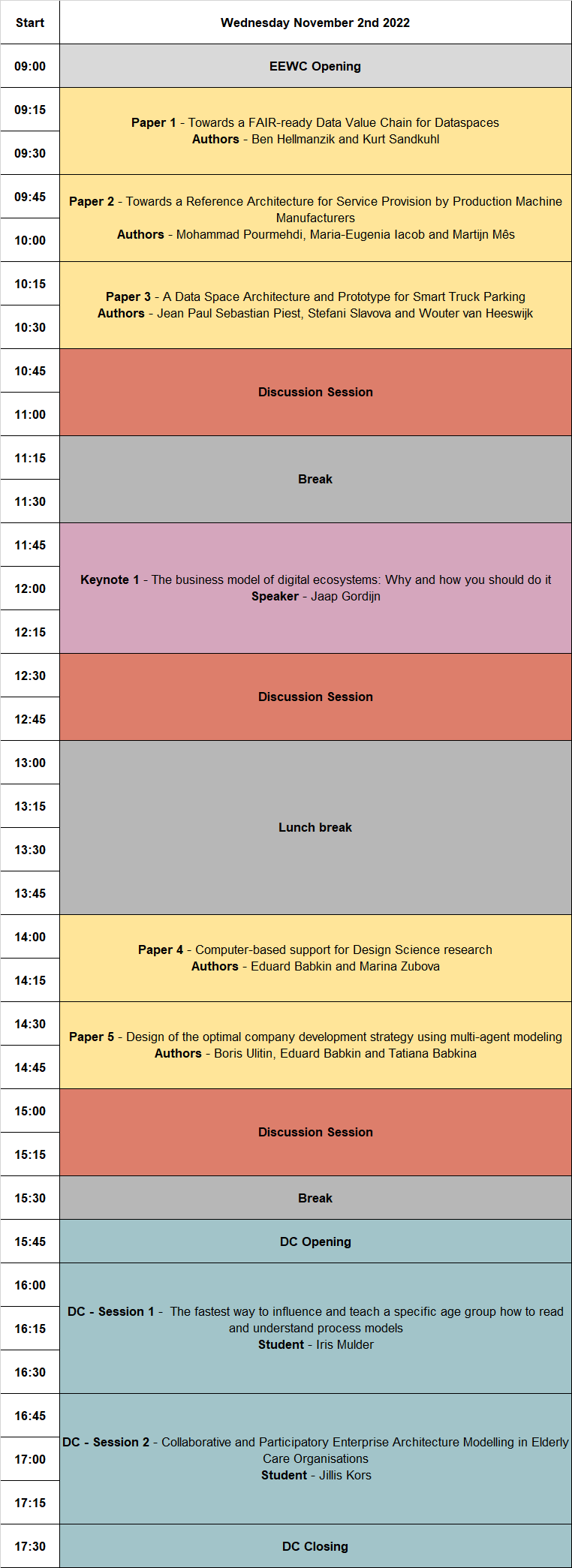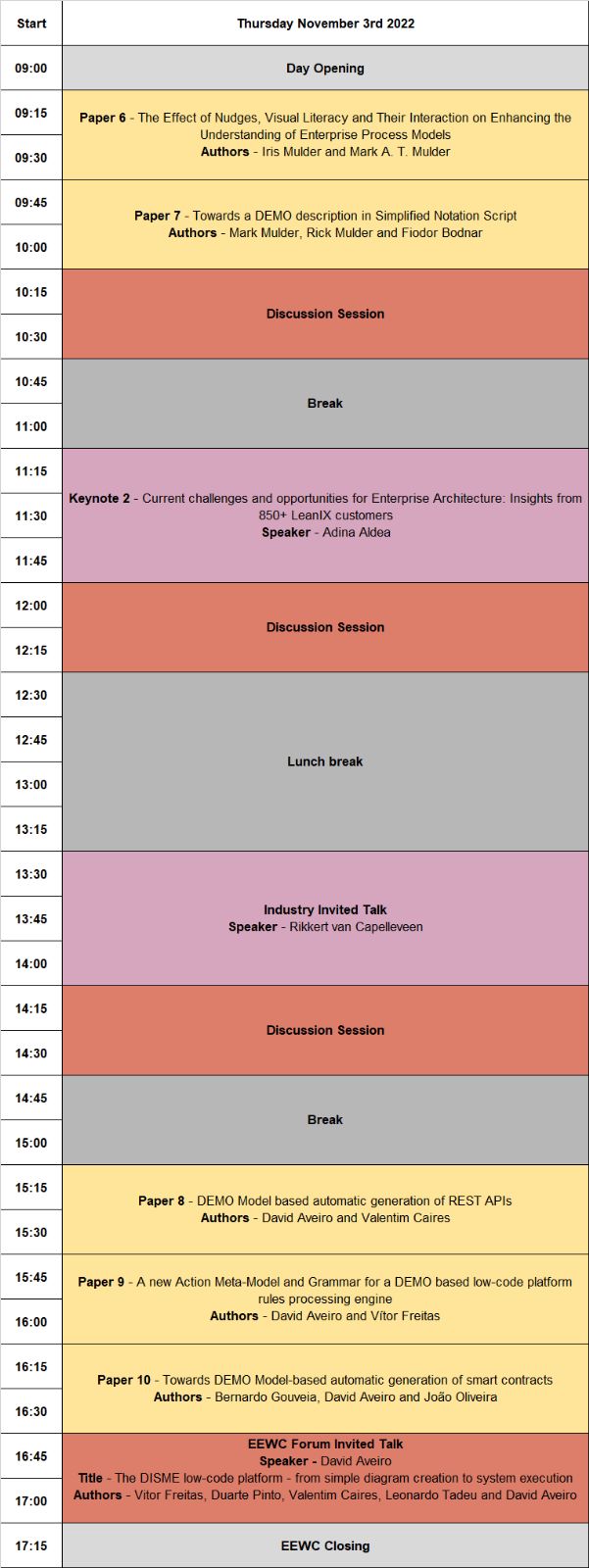Program

- Paper 1 – Towards a FAIR-ready Data Value Chain for Dataspaces
- Authors – Ben Hellmanzik and Kurt Sandkuhl
- Abstract -Digital transformation has resulted in the availability of more data in higher quality and business models aiming at exploiting them,
both on the level of individual enterprises and digital ecosystems. Among the essential elements of business models are the value offering made to target groups and the value creation required for this. Using the example of the maritime dataspace MARISPACE-X, the paper investigates an
approach to support business model development combining data value chains with data sovereignty based on the FAIR principles as differentiating feature. The contributions of this paper are (1) an innovative dataspace as example case for business model development, (2) an approach to integrate FAIR principles into data value chains, and (3) analysis of existing literature in the field.
- Paper 2 – Towards a Reference Architecture for Service Provision by Production Machine Manufacturers
- Authors – Mohammad Pourmehdi, Maria-Eugenia Iacob and Martijn Mes
- Abstract – Producers of manufacturing equipment could, instead of just selling products, also offer their clients customized services to increase customer satisfaction, gain competitive advantages, and increase their profits. These goals can be reached by helping the customers optimize their processes and improving their reliability and flexibility. This can be done when the customers invest in new advanced machines and a planning and control tool connecting the machines and the processes in between them. More specifically, this will become possible by introducing and integrating active data management and embedding analysis and planning applications in the current architecture of companies. All of the processes currently being done manually in the customer companies, from monitoring to production planning based on direct observation and the experience of production managers, can be automated using these applications. This paper presents a reference architecture supporting these processes and validates the developed models based on a real case study of a steel fabrication machine producer and its customers.
- Paper 3 – A Data Space Architecture and Prototype for Smart Truck Parking
- Authors – Jean Paul Sebastian Piest, Stefani Slavova and Wouter van Heeswijk
- Abstract – The logistics sector experiences an increasing shortage of secure truck parkings, in part due to lacking insight into occupancy rates. Extending earlier work – in which a variety of machine learning approaches are evaluated to predict truck parking occupancy – this paper presents a data space architecture and prototype for smart truck parking. The research builds upon case study research and 1.5 years of real-world data of a truck parking in Deventer, the Netherlands. Deploying the conceptual design from prior work, the main contributions of this paper are: (1) a data space architecture for smart truck parking, and (2) a prototype for a smart truck parking application. The architecture is rooted in the international data spaces reference architecture model, modelled using the ArchiMate language and specification, and validated by means of expert opinion. The cross-industry standard process for data mining is utilized to develop and deploy a prototype, based on a single-case mechanism experiment, for a smart truck parking application. Future research can focus on developing ontologies to extend the current conceptual representation of the data objects and the experimental development of federative machine learning approaches among truck parkings.
- Paper 4 – Computer-based support for Design Science research
- Authors – Eduard Babkin and Marina Zubova
- Abstract – This research addresses the problem of insufficient methodological and instrumental support for conducting design science (DS) research. This problem is highly relevant for novice researchers who may experience difficulties understanding and executing the research. In this work, we use the design science research methodology (DSRM) that represents the sequence of research stages and contains recommendations to guide the researcher. However, even if the DSRM activities may seem evident to the researcher, there is a potential risk of bogging down in details and losing the main focus of the research. For this reason, we extend DSRM with the System identification stage to focus more on the environment where the result of the research (artefact) is to be applied. In addition, we suggest using the Object Management Group (OMG) Essence standard to describe the main concepts and activities of the DS research based on the DSRM. The built OMG Essence model for DS research provides opportunities for better learning and understanding of the domain, monitoring the project’s health and planning the following activities. To implement the OMG Essence model, we propose the conceptual model of the Essence standard. In this work, we use Jira as an example of popular software to create a template project for DS research according to the conceptual model. Jira covers most of the stakeholders’ requirements and has opportunities for customization. In addition, we conduct usability testing to ensure students can comfortably use the system. Six students interacted with the prototype, and 5 of 6 would like to use the tool in their future research. However, it should be said that OMG Essence terminology is rather specific and may require additional effort to comprehend. And the benefits of using OMG Essence in the DS research projects also need further investigation in a long term.
- Paper 5 – Design of the optimal company development strategy using multi-agent modeling
- Authors – Boris Ulitin, Eduard Babkin and Tatiana Babkina.
- Abstract – The study is aimed at determining the optimal strategy for the development of the company in terms of increasing the number of loyal customers using multi-agent modeling methods. The constructed model takes into account not only the main characteristics of the company’s customers, but also a set of market tools available to the company at various stages of its existence to attract customers. The multi-agent model developed using the platform NetLogo can also be applied in other domains characterized by a high concentration of analogous (competing) entities (agents, goods, companies).
- DC Session 1 – The fastest way to influence and teach a specific age group how to read and understand process models
- Student – Iris Mulder
- Abstract – PhD proposal
- DC Session 2 – Collaborative and Participatory Enterprise Architecture Modelling in Elderly Care Organisations
- Student – Jillis Kors
- Abstract – For more than thirty years, Enterprise Architecture (EA) has been and still is an effective way of visualizing business processes, used applications and technology supporting the applications. Enterprise Architecture Modelling (EAM) is about stakeholder collaboration and participation (deciding, communicating and finding solutions that can be achieved “through communication, negotiation and collaboration”). It is the architects task is to connect the strategic level with the tactical and operational level and the architect involves stakeholders at those levels in the EAM process. In search of methods that are suitable for this task ‘The Theory of Inventive Problem Solving’ (TRIZ) caught our attention. It is expected to be an effective way of dealing with the EAM process when involving stakeholders. TRIZ provides tools for every step. But because we cannot rely on a significant amount of literature describing results of TRIZ used in EAM and we do not know if it provides results in our project we formulated the following research question: What are the barriers and enablers of the Theory of Inventive Problem Solving (TRIZ) when applied to stakeholder collaboration and participation in enterprise architecture modelling? As part of an EngD project we applied TRIZ in a single case and present our findings. We end our paper with practical implications and suggestions for future work.

- Paper 6 – The Effect of Nudges, Visual Literacy and Their Interaction on Enhancing the Understanding of Enterprise Process Models
- Authors – Iris Mulder and Mark A. T. Mulder
- Abstract – In Enterprise Engineering (EE), like other fields, visual information has several advantages over text and we are used to represent a process model as visual information. However, little is known about the contributing factors that influence the understanding of these process models. Visual literacy and nudges are two potential contributing factors to the ability to understand process models and reduce clutter. In this study, we researched by using an online questionnaire (N = 37) whether we could enhance the understanding of process models with the help of nudges, visual literacy and the interaction effects between the nudges and visual literacy. We executed a univariate ANOVA to compare the effect of the nudges on the understanding of process models with the two nudge conditions, visual literacy and all possible interactions as predictors. The results showed that nudges do not significantly influence the understanding of process models, which was not in line with our expectations. Visual literacy may have a significant influence, which aligns with our expectations. There was one significant interaction between visual literacy and the arrow nudge; however, not in the direction that we expected, therefore, not in line with our expectations. Given our small sample size, our significance could rest on a coincidence. We offer no open-and-shut conclusions about enhancing the understanding of process models with the help of nudges, visual literacy and the interaction effects between the nudges and visual literacy.
- Paper 7 – Towards a DEMO description in Simplified Notation Script
- Authors – Mark Mulder, Rick Mulder and Fiodor Bodnar.
- Abstract – The core methodology of Enterprise Engineering (EE) is Design and Engineering Methodology for Organisations (DEMO) and has been the subject of modelling tools. This methodology can be split into a process part and a notation part, describing the metamodel and its visualisation. The way the notation of the methodology has been described for these tools has been different. This paper describes the DEMO notation using the grammar of the Simplified platform as an exercise towards a complete notation grammar that can describe all existing and possibly future notations. The grammar is part of the Simplified platform and the notation is the open source definition of the notation part of the DEMO methodology. We have chosen a practical approach to the development of the notation script and think out-of-the-box by not creating a theoretical box a priori.
- Paper 8 – DEMO Model based automatic generation of REST APIs
- Authors – David Aveiro and Valentim Caires
- Abstract – The development of APIs for integration of different information systems can lead to repetitive work, amounting to simple translation of variables and methods, taking into account the implemented systems. Low-code platforms open the opportunity of automatic generation of APIs, both for incoming and outgoing data and/or services actions. Based on the data models of a low-code information system, we can easily create endpoints for providing simple lists of data items or even the results of complex queries or operations, by simple drag and drop operations in a friendly GUI, as well as for enacting internal tasks on the system. Likewise, we can also automatically scan provided data by external APIs that our system can call and match it with internal data, also in a friendly GUI, facilitating the integration of external information into our local system.
- Paper 9 – A new Action Meta-Model and Grammar for a DEMO based low-code platform rules processing engine
- Authors – David Aveiro and Vítor Freitas
- Abstract – We consider current Design and Engineering Methodology for Organizations (DEMO) Action Rules Specification to be unnecessarily complex and ambiguous. Even while using a “structured English” syntax similar to the one used in SBVR, such specifications are: incomplete while not containing enough ontological information to derive a functional implementation; and complex by containing mostly unneeded specifications. We propose a new meta-model for DEMO’s Action Model in the form of an EBNF syntax which is being implemented in a prototype that directly executes DEMO models as an Information and Workflow System. This prototype includes an action engine that runs DEMO transactions and the enclosed actions specified in our approach. We are currently integrating Blockly in our solution to allow syntactically correct visual programming of our proposed new Action Rule language that includes constructs to evaluate logical conditions, update the state of internal or external information systems, obtain input and provide output (formatted with WYSIWYG template editor) to users, among others.
- Paper 10 – Towards DEMO Model-based automatic generation of smart contracts
- Authors – Bernardo Gouveia, David Aveiro and João Oliveira
- Abstract – The production of self-executing computational agreements in the form of smart contracts remains a manual coding endeavour that hinders the widespread adoption of solutions that run on top of a distributed ledger technology such as blockchain. We explore the automatic generation of smart contracts based on a visual composition of reusable action rule specifications and other elements from the action model of the DEMO methodology. Several design and implementation considerations entail this choice of SC generation, all of which motivated a smart contract-enabled extension of DEMO’s way of modelling. The main research contribution is a foundation of synergistic knowledge accompanied by an extension proposal involving DEMO and smart contracts that can be built upon in future business cases where enterprise interoperability supported by blockchain technology is a requirement.

Industry Invited Talk
- Speaker – Rikkert van Capelleveen
- Bio – Rikkert van Capelleveen works at Achmea and is active in the field of innovation and the future of the digital insurer. For example, he was involved in AI projects within the Care & Health Division. He is currently responsible for the Data & Digital business unit within Achmea.
- EEWC Forum Invited Talk – The DISME low-code platform – from simple diagram creation to system execution
- Authors – Vitor Freitas, Duarte Pinto, Valentim Caires, Leonardo Tadeu and David Aveiro
- Abstract – An overview of the Dynamic Information System Modeller and Executor, an enterprise engineering, DEMO based, open source, low code platform with an Adaptive Object Model approach for workflow management in organizations. An alternative take, seeing an organization as a living organism, thus providing the tools for instant change in the processes to immediately reflect on their execution. We detail the multiple components of the System Modeller and how they interconnect with each other to produce the system executor that can be used by users for their day-to-day workflow in their organizations.
